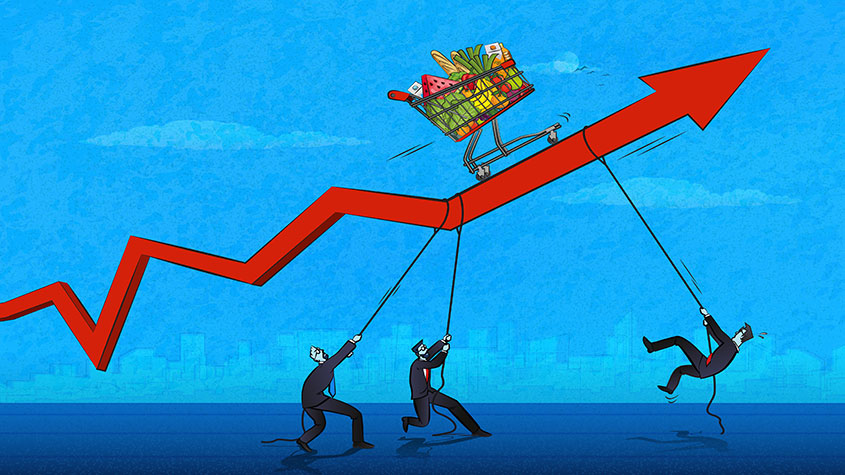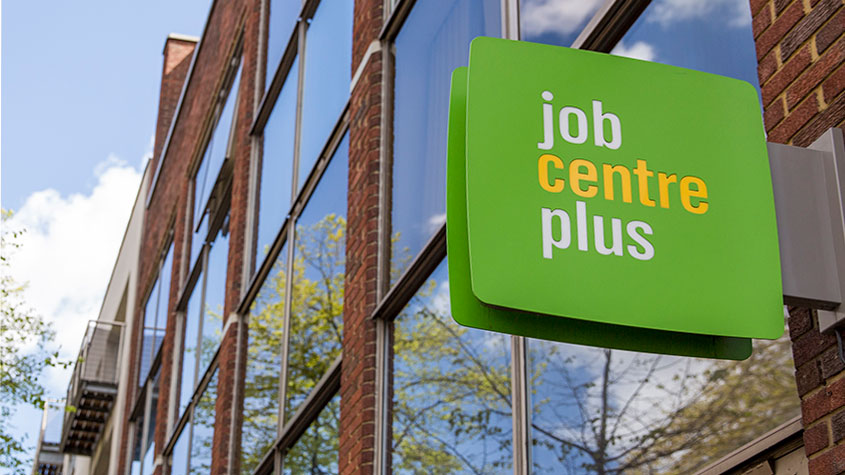Wages still aren’t keeping up with the cost of living
The UK jobs market continues to boom, but wages still aren’t keeping up with the rising cost of living. John Stepek explains why.


The British jobs market is still booming.
Unemployment is almost as low as it was before the pandemic. Vacancies are at record levels. The number of people with jobs is at record levels. The number of people switching jobs is at record levels.
And yet, wages still aren’t keeping up.
MoneyWeek
Subscribe to MoneyWeek today and get your first six magazine issues absolutely FREE

Sign up to Money Morning
Don't miss the latest investment and personal finances news, market analysis, plus money-saving tips with our free twice-daily newsletter
Don't miss the latest investment and personal finances news, market analysis, plus money-saving tips with our free twice-daily newsletter
What’s going on?
The labour market is very tight, yet wages are still lagging
The UK labour market remains extremely strong. In the three months to the end of December 2021, the unemployment rate fell to 4.1% from 4.3%. It’s not yet back below the levels seen before the pandemic, but it’s really not far off it now.
The number of employees on payrolls hit a fresh record high of 29.5 million. The number of job vacancies in the three months to the end of January 2022 rose to a new record of nearly 1.3 million. There are now 4.3 vacancies for every 100 existing jobs, which is – you guessed it – a record high.
In other words, the labour market is very tight. Employers need more workers than ever, but at the same time, there are not a lot of them to go around.
So it’s no surprise that job switching also hit a fresh record high in the last quarter of 2021, with nearly a million people switching to (presumably) bigger and better things. It seems that the “great resignation” is not restricted to the US.
There’s also a bit of a clue as to why the market is so tight right now. It’s not the whole story, but economic inactivity (basically, people over 16 and under 65 who aren’t actively looking for work, which includes retired people, housewives and househusbands, and students, among others) rose to 21.2%, which is a percentage point higher than before the pandemic.
The idea that there may be a proportion of people who left the workforce during the pandemic and have no plans (or are unable) to return makes sense.
Yet wages are still struggling to keep up, despite the hyperventilating quotes from various recruitment companies in my inbox about how the job market is awash with offers and counter-offers.
Average weekly earnings, excluding bonuses, grew by 3.7% in the last three months of 2021, compared to the final quarter of 2020. Including bonuses, they were up by 4.3%.
Trouble is, the headline inflation figure averages 4.4% over that period. So as a result, wages fell in “real” terms (ie, after inflation) by 0.8%, or by 0.1% if bonuses are included.
Worse still, that almost certainly understates the issue. The headline inflation figure is CPIH, which is the consumer prices index including owner occupiers’ housing costs. Like most “new” headline measures of inflation, it somehow always comes in lower than the measure it replaced, which was CPI.
CPIH, as of December, was rising at an annual rate of 4.8%; CPI was at 5.4%. And the measure that CPI replaced, all the way back in 2003? Well RPIX (the retail prices index excluding mortgage interest) was running at 7.7% (we’ll get the latest figures for January tomorrow – don’t expect them to improve much, if at all).
The only good way forward is to boost productivity
This is an interesting tug of war. In some ways it’s not too dissimilar to the supply chain question. Is this all just a matter of pandemic-era disruptions being ironed out? Are employers facing an artificial surge in demand which they’re now compensation for with a hiring boom that they’ll regret? Or does it represent a lasting shift?
The difference however, between supply chains and employment, is that the latter is much “stickier” (as economists put it) than the former. The price of goods will go up and down pretty smoothly to accommodate demand.
The price of labour adjusts far more lumpily. People generally don’t accept pay cuts (not in nominal terms at least). So labour prices mostly adjust via unemployment and recession – companies go bust or lay people off. This is socially disruptive and politically toxic, which is another reason that central banks get very edgy about the idea of wages rising rapidly.
The point to watch today is that the pandemic presented the unusual scenario where supply collapsed (because we were all locked down) but demand didn’t (because governments largely stepped in to pay workers where employers could not).
That created genuine pent-up demand which is still in the process of being unleashed. The question now is whether this can turn into a virtuous cycle of rising employment, rising wages, rising economic activity, rising corporate profits, rising investment, and rising productivity – or whether it all blows up because something pops a gasket at one of those steps.
Hurdles include the fact that we have a cost of living situation (I prefer not to use the word crisis quite yet) which is almost certain to deteriorate. If that causes consumers to rein in spending, then you could end up with a slowdown, and that could get unpleasant.
That’s one reason to hope that wages can rise to compensate for cost of living increases. Higher wages help to incentivise employers to improve productivity with innovation (because it becomes impossible to simply hire more cheap labour to patch over structural deficits in the organisation).
So, while you don’t want a wage-price spiral, rising pay is a key component of the virtuous circle that we’d like to see.
One thing to note on the wage front is that while real pay fell, the data did come in ahead of market expectations. That might be a sign that we’re starting to see the apparent advantage that employees have feed into the system.
In any case, there’s certainly nothing here to make the Bank of England think twice about raising interest rates further. And I suspect that January’s inflation data – which we’ll be covering tomorrow – won’t have any comfort for the Monetary Policy Committee either.
Get the latest financial news, insights and expert analysis from our award-winning MoneyWeek team, to help you understand what really matters when it comes to your finances.
John Stepek is a senior reporter at Bloomberg News and a former editor of MoneyWeek magazine. He graduated from Strathclyde University with a degree in psychology in 1996 and has always been fascinated by the gap between the way the market works in theory and the way it works in practice, and by how our deep-rooted instincts work against our best interests as investors.
He started out in journalism by writing articles about the specific business challenges facing family firms. In 2003, he took a job on the finance desk of Teletext, where he spent two years covering the markets and breaking financial news.
His work has been published in Families in Business, Shares magazine, Spear's Magazine, The Sunday Times, and The Spectator among others. He has also appeared as an expert commentator on BBC Radio 4's Today programme, BBC Radio Scotland, Newsnight, Daily Politics and Bloomberg. His first book, on contrarian investing, The Sceptical Investor, was released in March 2019. You can follow John on Twitter at @john_stepek.
-
 How cancelling unused direct debits could boost your pension by £37,000
How cancelling unused direct debits could boost your pension by £37,000A new year refresh of your spending could save you money and help boost your pension pot.
-
 NS&I cuts interest rates on 8 savings accounts
NS&I cuts interest rates on 8 savings accountsNS&I will now offer less attractive interest rates for customers wishing to lock their savings away to grow for one, two, three or five years.
-
 The cost of petrol in the UK compared with the rest of the world
The cost of petrol in the UK compared with the rest of the worldNews The price of petrol in the UK went through the roof last year, but has since settled. We look at how UK petrol price compares with the rest of the world.
-
 Petrol prices explained: What makes up the price of a litre of petrol?
Petrol prices explained: What makes up the price of a litre of petrol?Briefings The cost of filling the average car with fuel is falling. Here’s what makes up the price of a litre of petrol.
-
 UK inflation falls to 10.7% but cost of living pressures remain
UK inflation falls to 10.7% but cost of living pressures remainNews CPI is down to 10.7% from last month’s 41-year-high of 11.1%
-
 Unemployment rises as over 50s head back to work
Unemployment rises as over 50s head back to workNews The latest figures from the Office for National Statistics showed a 0.1% increase in unemployment, but a decreased rate of inactivity.
-
 What is a recession? UK impact explained
What is a recession? UK impact explainedAnalysis Office for National Statistics (ONS) figures show UK GDP growth has gone into reverse. But what does a recession mean?
-
 UK inflation hits 41-year high of 11.1%
UK inflation hits 41-year high of 11.1%News The rising costs of energy and food have pushed the figure up to its highest level since 1981.
-
 What is inflation and how does it affect you?
What is inflation and how does it affect you?The latest inflation figure is released each month. What is inflation and how does it impact your personal finances?
-
 UK inflation back to 10.1%
UK inflation back to 10.1%News UK inflation creeps back to its 40-year high from the summer, driven by rising food costs
